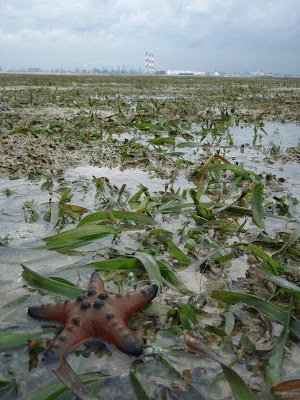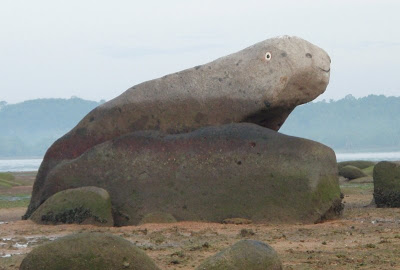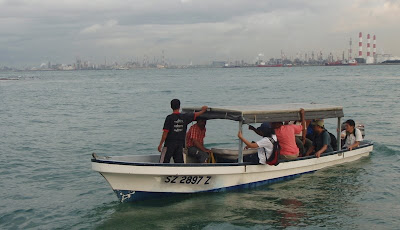Seventy First Discovery Posting:
My second trip to Cyrene reef and I was knobbly eyed again like the first time round.
This is because Cyrene reef is the only known place in Singapore at the moment where the knobbly sea stars are commonly seen. A last count by Star Trackers recently showed that there is as much as 186 individuals on Cyrene! Read more about it on the Star Trackers' blog (http://startrackers.blogspot.com/).
And if you are wondering how a knobbly sea star looks like, here are 3 individuals (picture below)!
 As this was my second trip, I decide to talk towards a part of the reef I didn't cover the last round and it was worth it as I came across possibly a juvenile cushion star (picture below)! First 'discovery'.
As this was my second trip, I decide to talk towards a part of the reef I didn't cover the last round and it was worth it as I came across possibly a juvenile cushion star (picture below)! First 'discovery'. Flipping the cushion sea star around would give you a better idea that this is indeed a seastar (picture below).
Flipping the cushion sea star around would give you a better idea that this is indeed a seastar (picture below). Discovery Note:
Discovery Note:1. They have this 'cute' or funny shape (however you wish to describe it) is probably because that such a shape would make it harder for its predators to take a bite at it.
2. Cushion sea stars are known to eat corals! Click on this link (here) to see an abstract of a paper which tells you more about it.
Of course, I also took many photos of the knobbly sea star I saw (pictures below). By the way, the ruler which you see in the photos is a 15cm ruler and it's there to aid Star Trackers for their project. Enjoy~





 Well, Cyrene doesn't only have knobbly sea stars, you can also find common sea stars (picture below) and other kinds of sea stars if you are lucky. Anyway, second 'discovery' is the common sea stars.
Well, Cyrene doesn't only have knobbly sea stars, you can also find common sea stars (picture below) and other kinds of sea stars if you are lucky. Anyway, second 'discovery' is the common sea stars. Discovery Note:
Discovery Note:1. Their tube feet are interesting as they are used for walking, handle food as well as breathing, and probably to catch prey as well, talk about multi purpose!
2. Sea stars get stressed when out of water, this is because while we have blood circulating our bodies, they have sea water circulating their bodies.
3. They are not as common as their name suggests. This is due to past over-collection and habitat lost past and present. So don't take them away from their homes when you see them. =)
4. Some sea stars are predators that prey on worms, crustaceans and bivalves while some are known to eat decayed plant matters.
5. Many sea stars eat with their stomach outside their body. When doing this, their tube feet will pull the two shells of a bivalve apart. And while still attached to their prey’s body, they extend their stomach out through their mouths into the bivalve shell.
And also sand dollars which are related to the sea stars (picture below), third 'discovery'.
 Discovery Note:
Discovery Note:1. Living sand dollars are coated in fine, harmless spines that made them very velvety.
2. The spines are movable and are used to dig into the sand or move around.
3. The dense layer of spines also helps to keep off sand and silt so there is a flow of oxygenated water across the body.
On Cyrene, I also saw the biggest piece of soft coral I have ever seen in Singapore's waters (picture below).
 Oh, if you are wondering what is the white thing in the picture. It's the 15cm I had with me. I placed it there to give everyone an idea how big is this piece of soft coral. Wow!
Oh, if you are wondering what is the white thing in the picture. It's the 15cm I had with me. I placed it there to give everyone an idea how big is this piece of soft coral. Wow!Cyrene is not only special because of the many knobbly sea stars you can see there. It is also special because it is a submerged reef (only exposed during low tide and is not connected to any land, thus amphibious landings are required) and it is located within the busy channels of our shipping lanes (near Jurong Island).
More about Cryene:
http://www.wildsingapore.com/places/cyrene.htm
Here's a picture to show you that it's near Jurong Island (picture below)
 And it's also not far from our city central (picture below). The background shows our central business district and also Sentosa.
And it's also not far from our city central (picture below). The background shows our central business district and also Sentosa.  And the most interesting knobbly individual for the day had to be this (picture below).
And the most interesting knobbly individual for the day had to be this (picture below). This (above) is also CK (a star trooper, not the one in Star Wars, but one from Star Trackers) favourite knobbly on Cryene.
This (above) is also CK (a star trooper, not the one in Star Wars, but one from Star Trackers) favourite knobbly on Cryene.And as we started to head back to our pick up point to go back, JH found a melibe nudibranch! A first sighting for me. Fourth 'discovery' (picture below)!
 Discovery Note:
Discovery Note:1. This looks very different from all the other nudibranchs I've seen.
2. One major difference is that it has an expandable hood (you can see it in the picture above) which it used to grab small and possibly slow prey aka food.
Soon, it was time to head back before we get 'buried' in Singapore waters. =P (picture below)
 Thanks to Ria again for organising this trip and others for making this trip another interesting one too!
Thanks to Ria again for organising this trip and others for making this trip another interesting one too!Extra:
a) If you are interested to visit Cyrene Reef, join in the blogging contest of "Let's go to Cyrene Reef", click here to find out more about it.
b) Check out Wildfilm's blog on the trip also on 21 July.
c) Wildfilm's blog again but for a trip on 22 July.
d) KS's blog for a trip to Cyrene on 22 July.





































